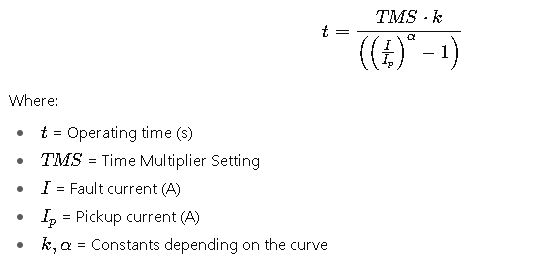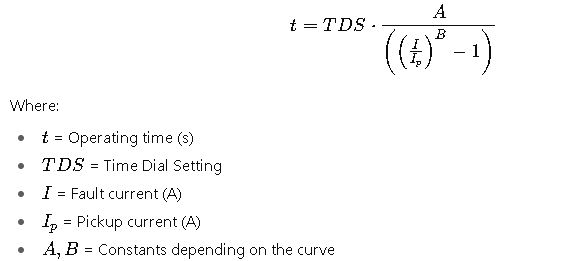Designing, selecting, and configuring overcurrent and inverse-time relays ensures reliable protection across industrial and utility networks. Both IEEE and IEC standards define time-current characteristics, operating equations, and application guidelines, supporting engineering analysis effectively.
Overcurrent & Inverse-Time Relay Selection Calculator — IEEE & IEC
How this calculator works
Formula reference
Fundamental Concepts of Overcurrent and Inverse-Time Relays
An overcurrent relay (OCR) operates when the current exceeds a preset threshold. Inverse-time relays extend this principle by introducing a dependency between fault current magnitude and tripping time: higher currents produce shorter operating times.
These relays ensure selectivity, sensitivity, and speed, which are essential for radial, ring, and meshed networks.
- Overcurrent relay (definite-time): Trips after a fixed time delay once pickup current is exceeded.
- Inverse-time relay (IDMT: Inverse Definite Minimum Time): Operates faster for higher multiples of pickup current, with a minimum time limit.
Typical Overcurrent and Inverse-Time Relay Settings
Relay settings are defined by:
- Pickup Current (Ip) – threshold multiple of rated current.
- Time Dial / Time Multiplier Setting (TMS/TDS) – scales the time characteristic.
- Curve Family – IEEE or IEC standardized formula applied.
Extended Tables of Common Settings
The following tables summarize commonly used values for IEEE and IEC inverse-time relays. These are the standard “multiples of pickup current” (M) versus operating time (T) with different curve families.
IEC Standard Inverse-Time Curves (IEC 60255-151)
| Multiples of Pickup (M = I/Ip) | Standard Inverse (SI) | Very Inverse (VI) | Extremely Inverse (EI) |
|---|---|---|---|
| 2 × Ip | 10.1 s | 13.5 s | 80.0 s |
| 4 × Ip | 3.0 s | 5.0 s | 20.0 s |
| 6 × Ip | 1.8 s | 3.0 s | 10.0 s |
| 8 × Ip | 1.3 s | 2.2 s | 6.5 s |
| 10 × Ip | 1.0 s | 1.8 s | 5.0 s |
| 20 × Ip | 0.5 s | 0.8 s | 2.0 s |
| 30 × Ip | 0.35 s | 0.55 s | 1.2 s |
| 40 × Ip | 0.25 s | 0.40 s | 0.9 s |
(Assuming TMS = 1.0. For other TMS, multiply accordingly.)
IEEE Standard Inverse-Time Curves (IEEE C37.112)
| Multiples of Pickup (M = I/Ip) | Moderately Inverse (MI) | Very Inverse (VI) | Extremely Inverse (EI) |
|---|---|---|---|
| 2 × Ip | 9.6 s | 14.0 s | 28.0 s |
| 4 × Ip | 3.2 s | 5.5 s | 9.5 s |
| 6 × Ip | 2.0 s | 3.5 s | 5.2 s |
| 8 × Ip | 1.5 s | 2.5 s | 3.6 s |
| 10 × Ip | 1.2 s | 2.0 s | 2.8 s |
| 20 × Ip | 0.55 s | 0.9 s | 1.1 s |
| 30 × Ip | 0.38 s | 0.65 s | 0.75 s |
| 40 × Ip | 0.30 s | 0.50 s | 0.55 s |
Practical Relay Setting Ranges
| Parameter | Typical IEC Range | Typical IEEE Range |
|---|---|---|
| Pickup Current (Ip) | 50–200% of rated CT secondary | 50–200% of rated CT secondary |
| Time Multiplier (TMS/TDS) | 0.05 – 1.2 | 0.1 – 15 (dial units) |
| Curve Families | SI, VI, EI | MI, VI, EI, Short-Time Inverse |
Core Formulas for Overcurrent and Inverse-Time Relays
Both IEC and IEEE curves are expressed mathematically using standardized equations.
General IEC Formula (IEC 60255)

IEC Constants:
| Curve Type | k | α |
|---|---|---|
| Standard Inverse (SI) | 0.14 | 0.02 |
| Very Inverse (VI) | 13.5 | 1.0 |
| Extremely Inverse (EI) | 80 | 2.0 |
General IEEE Formula (IEEE C37.112)

IEEE Constants:
| Curve Type | A | B |
|---|---|---|
| Moderately Inverse (MI) | 0.0515 | 0.02 |
| Very Inverse (VI) | 19.61 | 2.0 |
| Extremely Inverse (EI) | 28.2 | 2.0 |
| Short-Time Inverse | 0.02394 | 2.0 |
Explanation of Variables
- Pickup Current (Ip): Typically set at 1.05–1.2 × maximum load current to avoid nuisance tripping.
- Fault Current (I): Determined by short-circuit calculations, considering source strength, line impedance, and fault type.
- Time Dial / Multiplier (TMS/TDS): Adjusts the tripping time to coordinate upstream/downstream protection.
- Curve Constants: Predefined by IEC/IEEE and must be selected per system application (distribution, industrial, transmission).
Real-World Applications of Overcurrent and Inverse-Time Relays
The true value of the Overcurrent and Inverse-Time Relay Selection Calculator – IEEE, IEC emerges when applied to real-world scenarios. Below are two detailed examples that illustrate practical engineering decision-making.
Case Study 1: Industrial Distribution System with Motor Protection
Scenario:
A medium-voltage industrial plant operates a 13.8 kV distribution network supplying several 2 MVA induction motors. Protection engineers must select overcurrent and inverse-time relays to safeguard the motors and ensure selective coordination with upstream breakers.
Key data:
- System Voltage: 13.8 kV
- Motor rating: 2 MVA (full-load current ≈ 83.7 A)
- CT ratio: 200/5 A
- Maximum load current: 90 A
- Short-circuit current at motor terminals: 6 kA
Relay selection steps:
- Determine Pickup Current (Ip):
Pickup must be above motor starting inrush but below minimum fault current.- Inrush ≈ 6 × FLA = 500 A
- CT secondary = 200/5 → ratio = 40
- Relay sees 500/40 = 12.5 A during starting.
- Pickup setting chosen = 2.0 × nominal CT secondary current = 2 × (90/40 = 2.25 A) ≈ 5 A.
- Select Curve Family:
Motors require quick tripping for high fault currents but tolerance during starting.- Very Inverse (IEC VI) is ideal: slower near pickup, faster at high multiples.
- Adjust Time Dial (TMS):
Using the calculator, TMS = 0.3 provides ~2.5 s trip at 10 × Ip, coordinating with upstream breaker (~0.5 s delay). - Check Selectivity:
Relay downstream clears faults within 3 s, while upstream protection at the substation trips after 5 s.- Coordination achieved.
Outcome:
The industrial motors are protected against sustained overcurrents and short circuits, without nuisance trips during starting.
Case Study 2: Radial Distribution Feeder Protection
Scenario:
A utility distribution feeder (11 kV, 15 km) supplies mixed loads including residential and industrial customers. Protection coordination between feeder relays and downstream fuses is essential.
Key data:
- Feeder rating: 11 kV, 10 MVA
- Load current: ~525 A
- Short-circuit current at feeder head: 8 kA
- Fuses at distribution transformers rated at 100 A
Relay selection steps:
- Pickup Setting:
- Load current = 525 A → relay pickup at 1.2 × load = 630 A (≈ CT secondary 6.3 A for 800/1 CT).
- Curve Selection:
- To coordinate with fuses (which are very fast at high multiples), the relay must be Standard Inverse (IEC SI).
- Coordination Check:
- At 2 × pickup (1260 A), relay delay ≈ 5 s → downstream fuses blow first.
- At 10 × pickup (6300 A), relay delay ≈ 0.5 s → still slower than fuses (~0.1 s).
- Upstream Backup:
- The substation breaker relay set at 1000 A pickup with 1.0 s margin.
Outcome:
The feeder relay coordinates with both downstream fuses and upstream relays, ensuring selective isolation of faults. Customers outside the faulted section remain unaffected.
Engineering Considerations in Relay Selection
When using an Overcurrent and Inverse-Time Relay Selection Calculator, engineers must balance several criteria:
- Selectivity: Ensuring only the nearest protective device trips.
- Sensitivity: Detecting even low fault currents (e.g., high-resistance faults).
- Speed: Fast clearing at high multiples of fault current to reduce equipment stress.
- Reliability: Must operate consistently under varying system conditions.
- System Expansion: Settings should anticipate future increases in short-circuit levels.
Practical Tips for Engineers
- Motor Protection: Use Very Inverse curves to tolerate starting currents.
- Feeder Protection: Standard Inverse curves provide coordination with fuses.
- Transformer Protection: Extremely Inverse relays handle inrush and protect against high fault levels.
- Time Dial Setting: Always leave 0.3–0.5 s coordination margin between relays.
- Pickup Current: Typically set at 1.2–1.3 × maximum load to avoid nuisance trips.
Common Mistakes to Avoid
- Setting Pickup Too Low: Causes nuisance trips during normal load fluctuations.
- Ignoring CT Saturation: Leads to underestimation of fault currents.
- Overlapping Time Curves: Results in non-selective tripping, blackouts, or equipment loss.
- Failure to Recalculate After Expansion: When new loads are added, relay coordination must be rechecked.